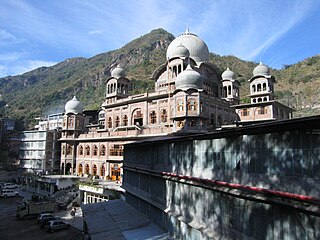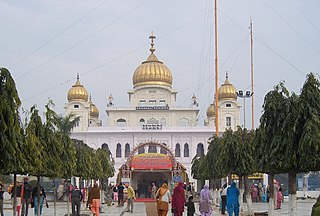Related Research Articles

Patiala district is one of the twenty three districts in the state of Punjab in north-west India.

The Dodda Aalada Mara, literally translated to Big Banyan Tree, is a giant approximately 400-year-old banyan tree located in the village of Kethohalli in the Bangalore Urban district of Karnataka, India. This single plant covers 3 acres (1.2 ha) and is one of the largest of its kind. In the 2000s, the main root of the tree succumbed to natural disease, and thus the tree now looks like many different trees. The Dodda Alada Mara is named a heritage tree.

Rupnagar district is one of twenty-three districts in the state of Punjab, India. The city of Rupnagar is said to have been founded by a Raja called Rokeshar, who ruled during the 11th century and named it after his son Rup Sen. It is also the site of an ancient town of the Indus Valley civilization. The major cities in Rupnagar District are Morinda, Nangal and Anandpur Sahib. Morinda is also known as Baghwāla "[The City] of Gardens." Morinda is located on the Chandigarh-Ludhiana Highway. The Bhakra Dam in Nangal lies on the boundary with the neighboring state of Himachal Pradesh. Dadhi is one of the most important villages of the district, particularly because of Gurudwara Sri Hargobindsar Sahib.

Sirhind-Fategarh is a town and a municipal council in the Fatehgarh Sahib district in the Indian state of Punjab.

Sikh architecture is a style of architecture that was developed under the Sikh Confederacy and Sikh Empire during the 18th and 19th centuries in the Punjab region. Due to its progressive style, it is constantly evolving into many newly developing branches with new contemporary styles. Although Sikh architecture was initially developed within Sikhism its style has been used in many non-religious buildings due to its beauty. 300 years ago, Sikh architecture was distinguished for its many curves and straight lines; Keshgarh Sahib and the Harmandir Sahib are prime examples.
The economy of Punjab is the 16th largest state economy in India with ₹8.02 lakh crore (US$96 billion) (FY2024-25) in gross domestic product and a per capita GDP of US$3460(264,000) ranking 19th amongst Indian states.

Shaheedi Sabha is a three-day annual religious congregation (get-together) organised every year in December at Gurdwara Fatehgarh Sahib, in the Fatehgarh Sahib district of Punjab, India to pay homage to the martyrdom of Chhotte Sahibzade Baba Zorawar Singh and Baba Fateh Singh, the youngest sons of the 10th sikh guru Guru Gobind Singh.

Fatehgarh Sahib district is one of the twenty-three districts of the state of Punjab, India, with its headquarters in the town of Fatehgarh Sahib.
Bora is a village in the Hoshiarpur district of Punjab, India.

Baru Sahib also known as the "Valley of Divine Peace" is located in Himachal Pradesh, India.

The Haveli Todar Mal popularly known as Jahaz Haveli or Jahaz Mahal is the 17th century residence (haveli) of Todar Mal, who became the diwan in the court of Nawab Wazir Khan, the Governor of Sirhind, under Mughal Empire. Today, it is remembered for the cremation of young martyred sons of Guru Gobind Singh and his mother.

Aam Khas Bagh is the remains of a highway-inn constructed for the use of royalty as well as common people. It was divided into two parts - the Aam for public use and the Khas for private use by the Royalty. This Royal inn was initially built by Akbar and planned by Mughal architect Hafiz Rakhna. It was rebuilt by Mughal Emperor Shah Jahan along the Mughal military road between Delhi and Lahore. The Royal couple used to stay here in the old building complex while going to and coming back from Lahore. Later on, some additions were made to this monument by Mughal Emperor Jahangir.

Gurdwara Fatehgarh Sahib is a Sikh gurdwara or place of worship in the city of Fatehgarh Sahib in the Indian state of Punjab. The gurdwara marks the 1710 conquest of the city by the Sikhs under the leadership of Banda Singh Bahadur. Sikhs captured the area and razed the fort built by Ferozshah Tughlaq to the ground.
Nandpur Kalaur is a conurbation of two villages in Bassi Pathana Tehsil in Fatehgarh Sahib District in Punjab State in India. The two villages are administrated separately but are physically contiguous with the main demarcation between them being the Bassi Pathana Road which passes between them.
Desh Bhagat University (DBU) is a private university located in Fatehgarh Sahib district in Punjab, established under The Desh Bhagat University Act, 2012 (Punjab Act No. 15 of 2013) of Punjab Legislative Assembly. DBU has four campuses in India at Fatehgarh Sahib, Shri Muktsar Sahib, Moga and Chandigarh and an international campus in Kenya.
Baba Sewa Singh is an Indian social worker and environmentalist, involved in the restoration and maintenance of the historic Gurudwaras at Khadoor Sahib. Baba Sewa Singh is a recipient of the Guru Gobind Singh Foundation Sewa Award in 2004. The Government of India honored him in 2010, with the fourth highest civilian award of Padma Shri.
Biodiversity Heritage Sites are notified areas of biodiversity importance in India.

The sacred groves is a zone of Biodiversity Park, Visakhapatnam located in the premises of Rani Chandramani Devi Government Hospital. It has more than 100 sacred plant species, which are medicinal herbs with religious importance. Many sacred plants are becoming rare and endangered. Hence they are to be reared, protected, and conserved. The zone was inaugurated on February 5, 2017, by Kambhampati Hari Babu, a member of parliament from Visakhapatnam, Andhra Pradesh.
Hansali Sahib village is located in the tehsil of Fatehgarh Sahib in Fatehgarh Sahib district in the state of the Punjab, India. It is situated 11.5 km (7.1 mi) away from Fatehgarh Sahib, which is both district and sub-district headquarters for Hansali village. Governance of the village is by gram panchayat. The total geographical area of Hansali is 278 hectares. Fatehgarh Sahib is also the nearest town to Hansali.
References
- ↑ "'Great Banyan Tree' in Fatehgarh Sahib to be Punjab's 1st biodiversity heritage site". Hindustan Times. 2017-09-18. Retrieved 2021-12-16.
- ↑ "In a first for Punjab, site of '300-year-old' banyan tree to get biodiversity heritage tag". The Indian Express. 2017-09-19. Retrieved 2021-12-16.
- ↑ "Great Banyan Tree".
- ↑ "Banayan Tree | Fatehgarh Sahib, Govt. of Punjab | India" . Retrieved 2021-12-16.